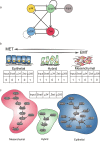Determining Relative Dynamic Stability of Cell States Using Boolean Network Model
- PMID: 30104572
- PMCID: PMC6089891
- DOI: 10.1038/s41598-018-30544-0
Determining Relative Dynamic Stability of Cell States Using Boolean Network Model
Abstract
Cell state transition is at the core of biological processes in metazoan, which includes cell differentiation, epithelial-to-mesenchymal transition (EMT) and cell reprogramming. In these cases, it is important to understand the molecular mechanism of cellular stability and how the transitions happen between different cell states, which is controlled by a gene regulatory network (GRN) hard-wired in the genome. Here we use Boolean modeling of GRN to study the cell state transition of EMT and systematically compare four available methods to calculate the cellular stability of three cell states in EMT in both normal and genetically mutated cases. The results produced from four methods generally agree but do not totally agree with each other. We show that distribution of one-degree neighborhood of cell states, which are the nearest states by Hamming distance, causes the difference among the methods. From that, we propose a new method based on one-degree neighborhood, which is the simplest one and agrees with other methods to estimate the cellular stability in all scenarios of our EMT model. This new method will help the researchers in the field of cell differentiation and cell reprogramming to calculate cellular stability using Boolean model, and then rationally design their experimental protocols to manipulate the cell state transition.
Conflict of interest statement
The authors declare no competing interests.
Figures





Similar articles
-
An Integrated View of Virus-Triggered Cellular Plasticity Using Boolean Networks.Cells. 2021 Oct 24;10(11):2863. doi: 10.3390/cells10112863. Cells. 2021. PMID: 34831086 Free PMC article. Review.
-
Relative stability of network states in Boolean network models of gene regulation in development.Biosystems. 2016 Apr-May;142-143:15-24. doi: 10.1016/j.biosystems.2016.03.002. Epub 2016 Mar 7. Biosystems. 2016. PMID: 26965665 Free PMC article.
-
Incomplete cellular reprogramming of colorectal cancer cells elicits an epithelial/mesenchymal hybrid phenotype.J Biomed Sci. 2018 Jul 19;25(1):57. doi: 10.1186/s12929-018-0461-1. J Biomed Sci. 2018. PMID: 30025541 Free PMC article.
-
Network biology approach to epithelial-mesenchymal transition in cancer metastasis: three stage theory.J Mol Cell Biol. 2015 Jun;7(3):253-66. doi: 10.1093/jmcb/mjv035. Epub 2015 Jun 23. J Mol Cell Biol. 2015. PMID: 26103982
-
Epithelial-to-Mesenchymal Transition: Epigenetic Reprogramming Driving Cellular Plasticity.Trends Genet. 2017 Dec;33(12):943-959. doi: 10.1016/j.tig.2017.08.004. Epub 2017 Sep 14. Trends Genet. 2017. PMID: 28919019 Review.
Cited by
-
An Integrated View of Virus-Triggered Cellular Plasticity Using Boolean Networks.Cells. 2021 Oct 24;10(11):2863. doi: 10.3390/cells10112863. Cells. 2021. PMID: 34831086 Free PMC article. Review.
-
A plausible accelerating function of intermediate states in cancer metastasis.PLoS Comput Biol. 2020 Mar 10;16(3):e1007682. doi: 10.1371/journal.pcbi.1007682. eCollection 2020 Mar. PLoS Comput Biol. 2020. PMID: 32155144 Free PMC article.
-
Decoding the principle of cell-fate determination for its reverse control.NPJ Syst Biol Appl. 2024 May 6;10(1):47. doi: 10.1038/s41540-024-00372-2. NPJ Syst Biol Appl. 2024. PMID: 38710700 Free PMC article.
-
Reducing State Conflicts between Network Motifs Synergistically Enhances Cancer Drug Effects and Overcomes Adaptive Resistance.Cancers (Basel). 2024 Mar 29;16(7):1337. doi: 10.3390/cancers16071337. Cancers (Basel). 2024. PMID: 38611015 Free PMC article.
-
Deep learning untangles the resistance mechanism of p53 reactivator in lung cancer cells.iScience. 2023 Nov 1;26(12):108377. doi: 10.1016/j.isci.2023.108377. eCollection 2023 Dec 15. iScience. 2023. PMID: 38034356 Free PMC article.
References
Publication types
MeSH terms
Grants and funding
LinkOut - more resources
Full Text Sources
Other Literature Sources
Miscellaneous

